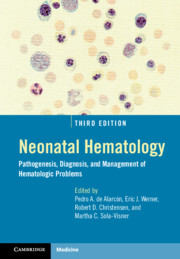Book contents
- Neonatal Hematology
- Neonatal Hematology
- Copyright page
- Contents
- Foreword
- Preface
- Contributors
- Section I Developmental Hematology
- Section II Bone Marrow Failure and Immune Disorders
- Section III Erythrocyte Disorders
- Section IV Platelet Disorders
- Section V Leucocyte Disorders
- Section VI Hemostatic Disorders
- Section VII Neonatal Transfusion Medicine
- Section VIII Neonatal Oncology
- Section IX Miscellaneous
- Chapter 23 Disorders of the Fetomaternal Unit
- Chapter 24 Reference Intervals in Neonatal Hematology
- Index
- Plate Section (PDF Only)
- References
Chapter 23 - Disorders of the Fetomaternal Unit
from Section IX - Miscellaneous
Published online by Cambridge University Press: 30 January 2021
- Neonatal Hematology
- Neonatal Hematology
- Copyright page
- Contents
- Foreword
- Preface
- Contributors
- Section I Developmental Hematology
- Section II Bone Marrow Failure and Immune Disorders
- Section III Erythrocyte Disorders
- Section IV Platelet Disorders
- Section V Leucocyte Disorders
- Section VI Hemostatic Disorders
- Section VII Neonatal Transfusion Medicine
- Section VIII Neonatal Oncology
- Section IX Miscellaneous
- Chapter 23 Disorders of the Fetomaternal Unit
- Chapter 24 Reference Intervals in Neonatal Hematology
- Index
- Plate Section (PDF Only)
- References
Summary
The fetal–placental–maternal unit can produce significant abnormalities in the neonate’s hematologic health at birth. A newborn can have disorders of white blood cells, red blood cells, or platelets, or any combination thereof. Neonatal cytopenias can result from dilution, peripheral destruction, or a defect in cellular production [1]. Maternal illness can be the cause of such abnormalities (Table 23.1). Close communication between the obstetrical provider and the pediatrician is important. This can allow for anticipation of a problem in order to mitigate the consequences, or to discover the cause if an unexpected cytopenia is detected.
- Type
- Chapter
- Information
- Neonatal HematologyPathogenesis, Diagnosis, and Management of Hematologic Problems, pp. 401 - 439Publisher: Cambridge University PressPrint publication year: 2021



